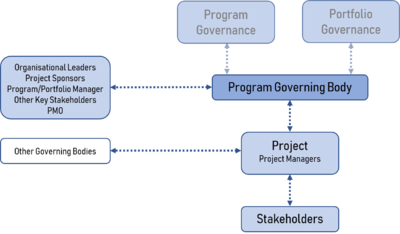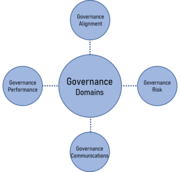Governance of Project Management
Contents |
Abstract
It appears that project governance is an ambiguous concept that suffer under a lack of an agreed on, generally accepted definition. This leads to the organisations developing their own understanding or interpretation of the concept, project governance, which fit their individually perspectives[1]. To investigate a common definition or use of project governance, the concept can be looked at from a bottom view or a top-down perspective. This article will focus on investigating the top-down perspective and look at governance starting at the corporate level and being implemented in project management through governance of project management. At the corporate level in an organisation, governance begins with the Board of Directors defining the objectives of the company and the role of projects in attaining these objectives[2]. Corporate governance also involves the relationships between the organisation’s board, management, shareholders, and other stakeholders[1][3]. The link between the corporate governance and the activities of project management within an organisation is called the governance of project management. It ensures that the project portfolio of an organisation is aligned to its objectives and is sustainable and delivered efficiently[3]. Different frameworks, principles and models has been established to guide project governance in an organisation. The three addressed in this article are; the thirteen principles of project governance which will help an organisation to avoid project failures developed by Association for Project Management (APM)[3], a guide to project governance framework implementation provided by Project Management Institute (PMI)[4], and the Project Governance Model for non-profit organisations proposed by Dr. Patrick S. Renz[5].
Project Governance
When talking about governance it is important to differentiate between the several different types that may exist. These include organisational governance, organisational project management (OPM) governance, and portfolio, program and project governance[6]. This article will mainly focus on the governance at a project level.
The main difference between governance at a project level and governance at a portfolio or program level is that project governance provides guidance and oversight for project management activities in order to deliver a product, service, or result. [4] Project governance is in the standard of Project Management Institute (PMI) defined as “the framework, functions, and processes that guide project management activities in order to create a unique product, service, or result to meet organizational, strategic, and operational goals”.[6] Governance framework refers to the four governance domains; alignment, risk, performance, and communication, with functions; oversight, control, integration and decision making, processes and activities for projects. The project governance framework will be further elaborated in the section of Implementation of Governance at a Project Level together with principles to avoid project failure and the Project Governance Model (for non-profit organisations).
Project governance is needed to ensure appropriate engagement of stakeholders and to guide and oversee the management of a project execution. It helps overcoming some of the challenges that may occur in the process of meeting the competing objectives of the project Triple Constraint: time, cost, and scope. In the every day changing and dynamic business environment, project governance should provide guidance for inputs, validations of projects and product requirements, effective execution, and the quality of the results. [4] To achieve this there are several processes that should be included in the project governance:
- Guiding an overseeing the management of project work by appropriate involvement in projects and interactions with the project manager on a regular basis
- Getting the appropriate people involved and ensuring engagement of the stakeholders
- Ensuring adherence to policies, standards, and guidelines
- Establishing governance roles, responsibilities, and authorities
- Decision-making regarding risk escalations, changes, and resources
- Monitoring performance[6]
Project Governance Organisation
The requirements of project governance should be looked at in the context of the project and organisational environment. If three separate scenarios of governing a project is looked at, an example of a project governance organisation structure could be as shown in figure ….
The three scenarios in which a project may be governed are: as a stand-alone project, within a program, or within a portfolio. In the case of a project being in a program or a portfolio, the project governance has interactions with the governance of the program or portfolio. When the project is a stand-alone project outside a program or portfolio it has its own, separate governing body. Then organisational leaders, project sponsor, program or portfolio managers, project, program, and portfolio management office (PMO), or other key stakeholders possible involved in the project are members of the project governing body. Next step in the structure is the interactions between this governing body and the project and project manager and then with the involved stakeholders.[4] As the figure shows, the possibility of other governing bodies interacting with the project and project manager is also a case. This scenario will be addressed in the next section.
There are many different responsibilities concerning project governance for the implicated in a project. The key project governance roles are the governing body, the project sponsor, the project manager, other key stakeholders and the PMO, but there may be additional roles depending on the complexity of the project. It is of most importance that the project governance come up with a plan which identify and describe the roles and responsibilities in a project. The roles and their responsibilities are described by PMI as:
- Project Governing Body
- Project Sponsor
- Project Manager
- Other Key Stakeholders
- Project Management Office (PMO)
Governance in a Multi-Organisation Environment
Implementing Governance at a Project Level
Every project is unique in terms of complexity, uncertainty, and risk levels that affect the managing and governing of the project. Project governance provide the needed guidance to project managers, sponsors, and stakeholders within the organisation. In the next sections three different guides to implement project governance at the project level will be presented.
Project Governance Framework
A project governance framework provides the project management team with structure, processes, decision making models, and tools for managing the project, while monitoring the quality of the project for at successful delivery. [4] Because of the different levels of complexity, uncertainty and risk in projects, it is impossible to have one governance framework that fits all projects. However, PMI provides a general categorisation of domains, functions, and processes that can be customised to any specific project and will help guide organisations in the implementation of governance in projects.
13 Principles to Avoid Project Failure
Project Governance Model
Limitations
Annotated bibliography
3-10
References
- ↑ 1.0 1.1 1.2 1.3 Kelly, É. V. (2010). Governance rules! The principles of effective project governance. Paper presented at PMI® Global Congress 2010—North America, Washington, DC. Newtown Square, PA: Project Management Institute.
- ↑ 2.0 2.1 2.2 Müller, Ralf (2011). Project Governance. Volume 12, Issue 5, Upgrade: The European Journal for the Informatics Professional
- ↑ 3.0 3.1 3.2 3.3 3.4 Association for Project Management (2011). Directing Change – A guide to governance of project management. 2nd edition, APM
- ↑ 4.0 4.1 4.2 4.3 4.4 4.5 4.6 Project Management Institute (2016). Governance of Portfolios, Programs, and Projects: A Practice Guide. PMI
- ↑ 5.0 5.1 5.2 Renz, Patrick S. (2007). Project Governance - Implementing Corporate Governance and Business Ethics in Nonprofit Organizations. Physica-Verlag HD
- ↑ 6.0 6.1 6.2 6.3 6.4 Project Management Institute (2017). A guide to the Project Management. Body of Knowledge (PMBOK guide). 6th Edition, PMI
- ↑ 7.0 7.1 AXELOS (2017). Managing Successful Projects with PRINCE2. 6th edition, TSO (The Stationery Office)


